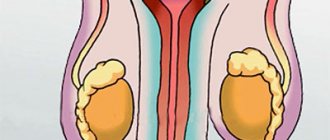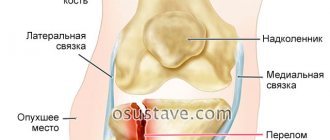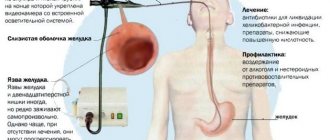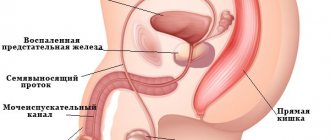Syndromes of lumbago disease 2292
The ilium is one of the paired bones of the pelvic ring. It connects to the sacral spine using a low-moving joint. With its help, the lower limbs are attached to the spinal column. In the lower lateral part is the acetabulum, which is an integral part of the hip joint.
If the ilium hurts, then several examinations will be required to make an accurate diagnosis. Potential causes of pain can be both pathological changes in the bone itself and damage to surrounding tissues. These may be diseases of the pelvic cavity, abdominal tumors, osteochondrosis and changes in posture, increased intra-abdominal pressure, damage to muscles, ligaments and tendons.
This material describes the most common diseases that are accompanied by pain in the ilium. In addition to potential causes, diagnostic methods, clinical manifestations, and the possibilities of modern effective treatment without the use of unsafe pharmacological drugs are described.
Can the ilium hurt?
The first and most important question: can the ilium hurt, or is it a reflected discomfort? How to determine and which doctor to contact if such a clinical symptom appears?
Let's start with the first question: the ilium can hurt on its own. It consists of dense tissue of bone trabeculae, covered on the outside with periosteum. It contains blood vessels and nerve endings. Therefore, any pathological changes in the bone with a violation of the integrity of the periosteum lead to a person experiencing serious pain. Potential causes include severe bruises with the formation of a hematoma inside the periosteum, cracks and fractures of the bone.
Various deformations can occur directly in the bone structure. This may include osteoporosis, osteomalacia and osteonecrosis. All three conditions differ in that the bone structure disintegrates, areas of rarefied matter form inside it, and calcium is washed out. The bone becomes fragile and susceptible to traumatic destruction even with a small load.
Another common group of reasons why the ilium itself hurts is tumor processes. These can be cavity intraosseous cysts filled with blood and lymph fluid. The inflammatory process that constantly occurs in them provokes swelling of the periosteum tissue and pain. Oncological tumors quickly metastasize to nearby bone structures. Cancer of the bone itself, osteosarcoma, is also not uncommon.
Next, let's look at other potential causes of pain in the ilium area.
What causes pain in the left side of the lower abdomen in a man?
All diseases that can provoke pain in this area should be divided into several blocks:
- diseases of the genitourinary system;
- musculoskeletal ailments;
- gastrointestinal pathologies.
Possible causes of abdominal pain
Concern about one's health is common to every sane, adequate and reasonable adult.
And this is quite normal and logical! Therefore, any physical ailments should certainly be alarming, since they may be symptoms of a disease.
It is thanks to timely attention to them that the development of a particular disease can be prevented.
Wait for the search to complete in all databases. Upon completion, a link will appear to access the found materials.
For example, what could pain in the lower abdomen on the left side indicate? So what if such a symptom is observed in a representative of the stronger sex? There are a number of diseases that can manifest themselves precisely in the form of pain in the left side of the lower abdomen.
Among the “purely male” diseases that can provoke pain and discomfort in the left side, there are 10 most common ones. Let's look at them in more detail.
Reasons why the ilium hurts
Let's look at why the ilium hurts if it itself has not been subjected to traumatic or other pathological effects. Most often it hurts in the area of the ilium when other structures of the musculoskeletal system are affected.
Common reasons for pain in the ilium are:
- lesions of the hip joint (deforming osteoarthritis, necrosis of the femoral head, its incorrect position in the cavity of the acetabulum, curvature of the lower extremities, arthritis, etc.);
- destruction of the sacroiliac joint (deforming osteoarthritis, displacement, formation of osteophytes, distortion of the pelvic bones, symphysitis, etc.);
- pathologies of the lumbosacral spine (degenerative dystrophic changes in intervertebral discs, hernias, protrusions, displacement of vertebral bodies relative to each other, spondyloarthrosis, ankylosing spondylitis, etc.);
- pathological changes in the muscles surrounding the bone, the most common syndrome is the iliac and piriformis muscles (in the latter case, the sciatic nerve is pinched, which causes severe pain);
- damage to the tendon and ligamentous apparatus in the area of the ridge and other surfaces;
- pathologies of the internal organs of the pelvis and abdominal bone (cystitis, colitis, bloating, adnexitis, prostatitis, stone in the ureter, etc.).
Only an experienced doctor can detect the exact reasons why the ilium hurts using special examination methods.
First of all, if such pain occurs, you should consult an orthopedist. During the initial examination, this specialist will already be able to exclude a number of diseases. Then he will prescribe examinations that will allow you to make an accurate diagnosis and prescribe effective and safe treatment.
It is not worthwhile to independently diagnose such clinical manifestations. Due to subjective perception, you are unlikely to be able to distinguish a somatic pathology of the intestines or uterine appendages from the destruction of the bone itself or the irradiation of pain from the lumbosacral nerve plexus.
Structure of the pubic bone
The pubic bone (os pubis) has a body (corpus ossis pubis, thickened part) and two branches:
- The superior branch of the pubic bone (ramus superior ossis pubis) is directed anteriorly, inferiorly and medially.
- The lower branch of the pubic bone (ramus inferior ossis pubis) is a continuation of the previous branch.
The pubic bone also has:
- The crest of the pubis (pecten ossis pubis) is the pointed upper edge of the superior branch of the pubic bone.
- Obturator crest (crista obturatoria) is the pointed lower edge of the superior branch of the pubic bone.
- Pubic tubercle (tuberculum pubicum).
- Symphyseal surface (facies symphysialis) for articulation with the pubic bone of the opposite side.
The ilium hurts on the right or left side
The ilium hurts on the right or left - this does not matter for making a diagnosis in principle. The topography of pain can only indicate the location of the focus of pathological changes.
For example, if the right ilium hurts due to damage to the radicular nerve against the background of degenerative dystrophic destruction of the intervertebral disc and a decrease in its height. In this case, the diagnosis will be: lumbosacral osteochondrosis at the protrusion stage. But the fact that the ilium hurts on the right side will mean that the topography of intervertebral disc degeneration is located on this side. Accordingly, when developing a course of manual therapy, the doctor will focus on carefully studying this particular segment.
If the left ilium hurts due to deforming osteoarthritis, then the diagnosis will be made accordingly. The patient’s card will indicate that he has left-sided deforming osteoarthritis of the 1st, 2nd or 3rd degree.
If the left ilium hurts due to damage to the abdominal organs, then the topography of the pathological process is important only in cases where paired organs are affected. These are the ureters, uterine appendages (tubes, ovaries). In case of damage to an area of the large intestine, a diagnosis of inflammation of the common colon, sigmoid, ileum, etc. can be established.
It doesn’t matter whether the ilium hurts on the left side or on the right, making an accurate diagnosis will require detailed diagnosis and exclusion of a number of pathological changes. Therefore, it is important to consult a doctor as soon as possible if symptoms appear at an early stage of the disease. This will allow you to start timely treatment and eliminate the likelihood of complications.
If you experience unpleasant sensations in the pelvic bones, you should contact an orthopedist, neurologist, or vertebrologist. These specialists will be able to understand the potential causes of pain. If necessary, they will prescribe a consultation with an andrologist, gynecologist, gastroenterologist, neurologist and other specialized specialists.
Veins of the pelvic area
The iliac region is located in the anterolateral part of the abdominal wall, delimited by the iliac crest in its upper-outer part and the sacrum and the lateral walls of the pelvic bones in the lower part.
The wing and lateral part of the body of the bone form the iliac fossa, in which the muscle of the same name originates. The right and left iliac regions in their upper part border with the right and left lateral region, respectively, in the lower part - with the suprapubic region, the internal borders are adjacent to the umbilical region.
The right iliac fossa contains:
- loops of the large intestine
- terminal ileum,
- the cecum with a vermiform appendix - the appendix.
The left fossa contains loops of the small intestine and the sigmoid colon.
Also located in the anterolateral region are:
- inferior vena cava,
- common and external iliac vessels and veins,
- branches of the lumbar nerve plexus,
- ureter,
- round ligaments of the uterus and ovarian vessels in women,
- vas deferens in men.
Blood supply
Blood vessels are located both inside the fibro-osseous bed and outside it, in the retroperitoneal tissue.
The fiber contains:
- common and external iliac veins,
- external and common iliac arteries,
- testicular artery and vein in men,
- ovarian artery and vein in women.
Inside the osteofibrous bed are the iliopsoas artery and small lumbar arteries.
Innervation
Inside the osteofibrous bed of the iliac fossa are located:
- femoral nerve,
- lateral cutaneous femoral nerve,
- small branches of the lumbar plexus.
In some cases, the ilioinguinal and accessory femoral nerve roots are also located in this area. In the retroperitoneal tissue there is a large femoral-genital nerve.
The pelvic organs are supplied with blood through vessels that arise from the abdominal aorta and their branches. These include:
- common superficial artery and its ducts;
- deep femoral artery;
- external genital branches;
- inguinal branches;
- gluteal vessels;
- umbilical cord, etc.
The outflow of blood passes through large main veins. They are parietal vessels accompanying the arteries of the same name, or massive venous plexuses. To understand the anatomical features of the pelvis, it is necessary to study in more detail the types, structure, functions and location of all the veins and arteries in this area.
Each artery in the body is accompanied by a pelvic vein of the same name. These blood vessels carry carbon dioxide-rich blood toward the heart. There are four largest:
- common iliac vein;
- internal iliac vein;
- external iliac vein;
- femoral vein.
An additional role in the outflow of blood is played by their ducts: veins of the rectum and urethra, uterine and cystic veins, middle hemorrhoidal, posterior veins of the scrotum, veins of the perineum, etc. The dorsal vein of the penis is responsible for sexual function in men, and in women - the whole uterine -vaginal venous plexus.
Massive venous plexuses in the pelvic area include:
- Pudendal plexus. It is located behind the symphysis pubis and is unpaired. In men, the venosus pudendali is located in front of the prostate gland and is closely connected with the prostatic venous plexus; in women, it is located in front of the bladder and urethra.
- The vesical plexus is the largest venous plexus of the pelvis. In men, the prostate plexus is closely adjacent to it. In the female body, anamostosis extends to the initial part of the urethra and connects to the veins of the vagina. The plexus also contacts the pudendal, sacral and rectal plexuses, numerous branches of the iliac vein and retroperitoneal tissue.
- Utero-vaginal plexus or venosus uterovaginalis. Located behind and on both sides of the vagina and cervix. Anomostoses with the veins of the external genitalia and surrounding venous plexuses: pampiniform, vesicovaginal, rectal. It has a large number of connections with the veins of the retroperitoneal space through the ovarian vein, visceral and parietal tributaries of the internal iliac vein.
Features of the anatomy of the veins of the hip region:
- a large number of connection points;
- gaping of the vein lumen after damage due to fixation of the vein walls to the pelvic wall;
- lack of valves in the ascending and descending directions, which contribute to the spread of infections;
- anastomosis with tributaries of the superior and inferior vena cava;
- the presence of porto-caval and cava-caval anastomoses (connections).
To solve the problem, you should visit a highly specialized doctor and undergo several simple examinations - ultrasound, venography and MRI. Having a complete picture of the condition of the blood vessels, it will be easy for a specialist to select a comprehensive and most effective treatment.
Diagnosis of diseases
If the iliac crest hurts on the right or left, then you need to conduct a thorough differential diagnosis. Already during the initial examination, an experienced orthopedist will rule out various pathological changes and give a recommendation for conducting only those studies that are necessary in your clinical case.
As a rule, if the iliac crest hurts, then examinations begin with:
- conducting a survey type X-ray (includes all the pelvic bones, the lumbosacral spine and the hip joint - allows to exclude deforming osteoarthritis, destruction of the iliosacral joint, traumatic lesions of the bone structure, etc.;
- Ultrasound of the internal organs of the abdominal cavity and pelvis;
- MRI examination of all pelvic structures.
If this is necessary, then intestinal examinations such as sigmoidoscopy or colonoscopy are performed. Consultation with a nephrologist, gynecologist and urologist is also indicated.
If the iliac crest hurts on the left, we recommend starting the examination with an X-ray of the lumbosacral spine. Most often, this localization of pain is inherent in osteochondrosis and its complications. And in case of right-sided localization and acute pain syndrome, accompanied by nausea and dizziness, we recommend that you consult a surgeon as soon as possible. This could be an attack of acute appendicitis.
Right sided pain
If signs of acute pain are felt on the right side, the cause of this is the same pathology. However, they can cause other complications - reduced mobility of the lower extremities, deformation of the bone segments of the pelvic girdle, accompanied by a feeling of discomfort. This condition can cause disability. In addition, pain in the area of the right ilium may have other causes:
- various pathologies of blood vessels;
- insufficient amount of nutrients.
- consequences of recent injuries.
- long-term use of synthetic hormonal medications.
- excess cortisol.
- old age of the patient.
- human activity associated with constant physical activity.
- intervertebral hernia.
- oncological diseases.
- osteochondrosis.
https://youtu.be/Hhe-V90lZ6Q
Treatment
The appropriate therapeutic course is prescribed to the patient only after completion of the diagnosis and diagnosis. Treatment includes several stages:
- A painkiller is administered.
- Blood transfusion is performed (for minor blood loss);
- An operation is performed in case of profuse bleeding (damaged vessels are ligated for subsequent therapy);
- The injured leg is fixed (a splint is placed on the victim’s limb);
- The skeleton is stretched (with unstable injuries).
Attention! In the case of a vertical fracture of a bone element, the integrity of the pelvic ring is disrupted. Damage to internal organs and bleeding are possible.











